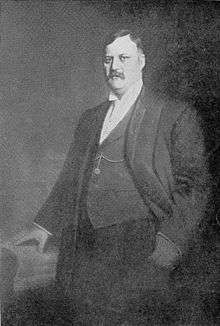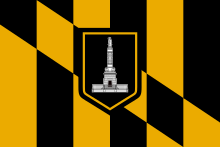E. Clay Timanus
E. Clay Timanus (September 2, 1863[1] – November 15, 1923) was the mayor of Baltimore from 1904 to 1907.[2][3] He assumed the office after the suicide of his predecessor Robert McLane.[3] He was succeeded by Democrat J. Barry Mahool.[3] His family owned a watermill.[4] The Great Baltimore’s Fire of 1904 almost destroyed the Most populated city of Maryland. Lucky for Baltimore there was a man who succeeded the previous Mayor named E. Clay Timanus a Republican, who was born in Baltimore in 1863. His family was in the grain and milling business, and when fifteen years old young Timanus became identified with this industry. He learned every branch and for a long time was associated with the Timanus Mills, on the Falls Road, near Cedar avenue bridge. Mr. Timanus became a member of the old Corn and Flour Exchange, now known as the Chamber of Commerce, and for years was one of the Board of Directors. He was also on the Executive Committee, of which body he was chairman for a considerable period. A Republican, he has always taken an active interest in political affairs. He was elected to the City Council, First Branch, for the terms 1897 to 1899 and 1901 to 1903 and was President of the Second Branch in 1904, when Mayor McLane died, thus automatically succeeding to the Mayoralty as stated heretofore. Mr. Timanus was elected to the Presidency of the Second Branch over Starr Gephardt, Democrat. By virtue of this office he was, too, President of the Board of Estimates. While a member of the City Council, particularly the First Branch, Mr. Timanus was much identified with all the more important matters that came before that body. He was Chairman of the Joint Special Committee which participated in matters pertaining to the sale of the city's interests in the Western Maryland Railroad. After serving the unexpired term of Mayor McLane, Mr. Timanus was a candidate for re-election on the Republican ticket, having defeated Frank C. Wachter in the primaries, but lost in the general election to J. Barry Mahool, the Democratic candidate. In 1911 he was again nominated but his opponent, James H. Preston, Democrat, was elected. Mr. Timanus was treasurer of the Republican State Central Committee in 1901, a member of the Public Service Commission for six years; was one of the vice-presidents of the Non-Partisan Greater Baltimore Extension League. "As stated it was during Mayor Timanus' administration that the construction of Baltimore's splendid sanitary and storm-water sewerage system began. It, therefore, fell to the lot of the then Mayor to inaugurate this great enterprise. A $10,000,000 loan for the purpose was approved by the voters May 2, 1905, legislative authority for which was granted April 7th, 1904. Ground for the sewerage system was broken October 22nd, 1906. This was quite a ceremonious function with the Mayor in attendance. The work was very energetically pushed, and consequently had well progressed when Mr. Timanus quit office.
E. Clay Timanus | |
|---|---|
 | |
| 33rd Mayor of Baltimore | |
| In office May 31st, 1904 – May 21st, 1907 | |
| Preceded by | Robert McLane |
| Succeeded by | J. Barry Mahool |
| Personal details | |
| Born | September 2, 1863 |
| Died | November 15, 1923 (aged 60) |
| Political party | Republican |
"The rebuilding of the burned area by the Burnt District Commission, of which the Mayor was a member, ex-officio, was also much advanced while Mr. Timanus was in office. Many important and oft times vexatious problems had to be solved and obstacles overcome. When Mr. Timanus succeeded to the Mayoralty agreements had been reached for fifty or sixty pieces of property, whereas two hundred and fifty pieces were necessary for the purposes and the consummation of the plans of the city. The report of the Burnt District Commission of October 23rd, 1907, shows that $7,425,318.32* had been expended for this purpose, i.e. property, and of this amount approximately $6,862,000 was spent while Mr. Timanus was in office. His administration, therefore, had much to do with the rebuilding and improvement of Baltimore. It was full of activity and witnessed important changes in the physical aspect of the city.
"In 1903 Olmsted Bros. made quite an extended report on the "Development of the public grounds for Greater Baltimore." They laid out a general scheme of park extension and a substantial beginning in the consummation of the plan was made during Mayor Timanus' administration.
"Major Richard M. Venable, then president of the Park Board, in cooperation with the administration, was very active in this idea—the systematic development of the parks—and devoted much time and labor to the project. Succeeding administrations have adhered to the plans then adopted, with but slight modifications. One feature has been described as "Baltimore's chain of parks"—that is, a number of public reservations connected by imposing highways."
- The Burnt District Commission acquired lots, etc., for the widening of streets and for certain dock improvements within the burned area, in accordance with a general plan proposed by the Emergency Relief Committee appointed immediately after the fire, but it (the Burnt District Commission) did not confine its activities to the devastated section. The widening of Light Street, from Pratt to Lee, technically outside the fire zone was yet a part of the general scheme. The municipal owned docks on the north side of the Basin, as far east as Jones Falls, were definitely included in the general scope of improvement (this section being in the destroyed areas) but the city piers east of the falls were designed and erected at a later date. Therefore the amount of money given above as expended during Mayor Timanus' administration was largely for the acquisition of property (real estate), and was not the total cost to the city for the rehabilitation of Baltimore after the fire. The actual work of widening, grading, paving streets and building piers was done by various departments of the city government, hence, to the expenditures given must be added the outlay by departments other than the Burnt District Commission, when arriving at a total."
References
- Coyle, Wilbur F. "E. Clay Timanus (1863-1923)". Archives of Maryland (Biographical Series). Retrieved 9 June 2016.
- Nettles, Deane. "Rock Mill/Timanus Grist Mill Dam". Cotton Mills of the Jones Falls. Baltimore Industry Tours. Retrieved 10 June 2016.
![]()
